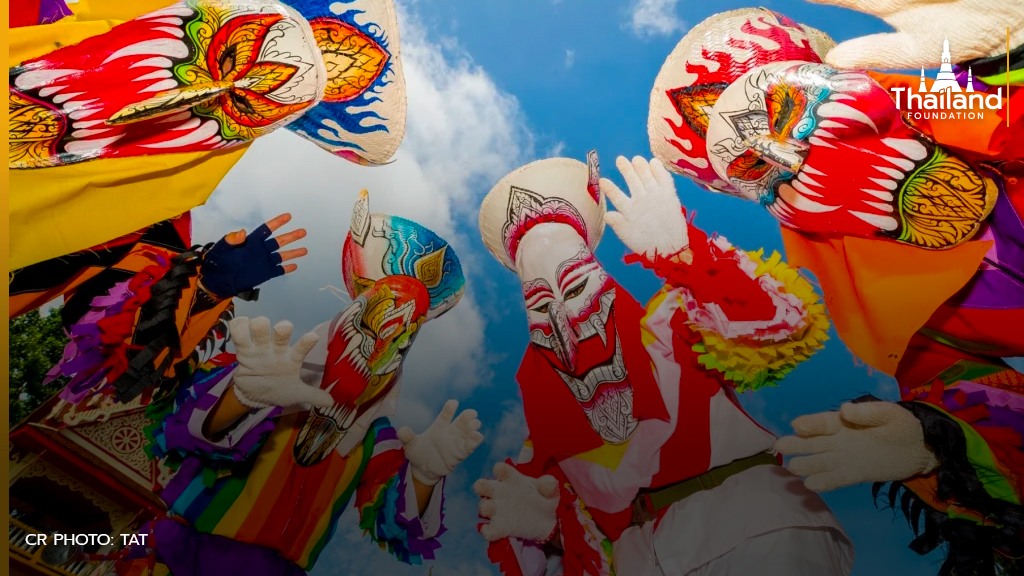Phi Ta Khon: The Happy Ghost Parade
Contents
What is Phi Ta Khon?
Phi Ta Khon [ผีตาโขน] is part of an auspicious and merry tradition called Boon Luang Festival [บุญหลวง] (the grand merit-making festival) of Northeastern Thailand (Isaan). Everyone is welcomed to join the Phi Ta Khon parade simply by wearing a spooky-looking mask and a dress made of discarded cloth. This tradition is observed every year in Dan Sai District, Loei Province, during the rainy season, or from late June to early July. People dressed as Phi Ta Khon will show off their funny dance moves and gestures to brighten up the atmosphere and entertain the crowd at the annual celebration, taking place on the streets across Dan Sai and almost everywhere in Loei, while the main ceremony is carried out at the Wat Phon Chai Temple.
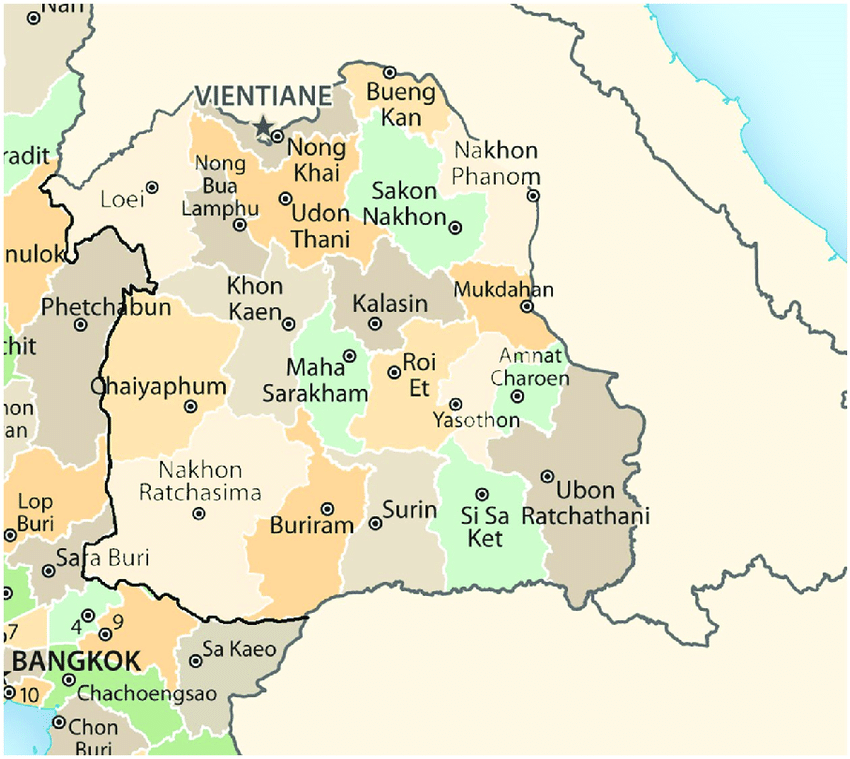 (Photo credit: https://www.researchgate.net/figure/Map-showing-the-northeastern-region-of-Thailand_fig1_338184495)
(Photo credit: https://www.researchgate.net/figure/Map-showing-the-northeastern-region-of-Thailand_fig1_338184495)
Origins
Phi Ta Khon is well known and loved by the Thai people because of its fun and quirky elements, but despite a long-standing tradition in Northeastern Thailand, no one can say for certain when or where it started. Today, the Phi Ta Khon tradition is considered an opportunity to observe three merit-making festivals at once, namely Boon Luang (the great merit-making festival), Boon Bang Fai (the traditional rocket festival), and Boon Sam Ha (warding off bad luck for the country), to worship the city’s guardian angels and holy spirits. Still, we have gathered three assumptions concerning the origin of Phi Ta Khon as follows:
The Legend of Vessantara and Madri
According to the Buddhist Jataka, Prince Vessantara is the last life of the Bodhisattva before his reincarnation as the Gautama Buddha. The legend has it that “Phi Ta Khon” came from the word “Phi Tam Khon” (ghosts following people), a scene when the generous Vessantara and his wife Madri are leaving the forest for the city. To bid farewell to the couple, forest angels, ghosts and animals disguise as humans and blend in with the villagers to see them off.
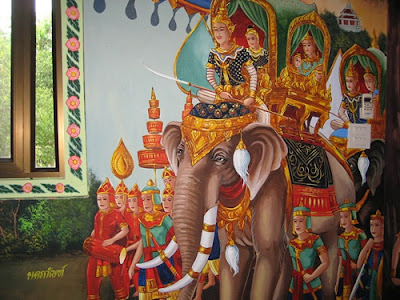 (Photo credit: http://mooaiw41.blogspot.com/2013/01/blog-post_3259.html)
(Photo credit: http://mooaiw41.blogspot.com/2013/01/blog-post_3259.html)
The Legend of Pu Ye-Ya Ye (Grandparents Ye)
In this legend, there was once upon a time a giant tree that reached the heaven, obscuring sunlight with its large trunks, branches and leaves, plunging the city into darkness, driving people into poverty since nothing could be cultivated. One day came an elderly couple, named the Grandparents Ye, who volunteered to cut down that colossal tree for only one request in return: remember them when they die. The grandparents then set off to fell the tree with large axes. After three months and three days, they were successful and the city and its people were able to see the bright sunlight once again. Unfortunately, the gigantic tree trunk fell on top of the grandparents and killed them instantly. To fulfil the couple’s wish, the villagers erected a spirit house in which the hair (called “khon” in Thai) of the grandparents was kept. This could be another possible origin of the term “Phi Ta Khon”
The Ancestral Spirits
The third theory states that Phi Ta Khon is a way to pay homage to the spirits of deceased ancestors, believed to have become guardian angels of the city and may bless the earth with fertility or curse it with famine. To please the ancestral spirits, the villagers arrange for the Phi Ta Khon parade. This practice is similar to an ancestral worship ceremony in the Lan Xang Kingdom (one of the greatest kingdoms in the Southeast Asia from 1353 to 1707), and also in Laos, where the Grandparents Ye are worshipped as an ancestral spirit.
How is Phi Ta Khon celebrated?
The Boon Luang merit-making festival lasts for three days. Phi Ta Khon will join the crowd on the first and the second days.
Day 1: Summoning Phra Upakhut (Phi Ta Khon Day)
The main event for today is the summoning of Phra Upakhut. According to a legend, Phra Upakhut is a Buddhist monk who attained the enlightenment and became an arahant. He had the power to perform miracles but chose to live in seclusion at the ocean’s navel. King Asoka the Great (268 to 232 BC) wished to host a celebration for seven years, seven months, and seven days to mark the completion of 84,000 temples and pagodas. To assure that his effort would be protected from evil spirits, King Asoka thus summoned “Phra Upakut” to watch over the auspicious celebration. That was when the tradition of summoning Phra Upakhut during important Buddhist ceremonies was established and later adopted by the Thai people.
In order to summon Phra Upakhut, the villagers will first build the Upakhut Hall. Next, one person will have to stand in the river and another person on the riverbank saying a prayer. The person in the water has to pick up a rock from the river and ask the other “Isn’t it Phra Upakhut?” The person standing on the bank must answer “No.” Repeat the whole act three times and change the rock. On the third time, the person on the bank will answer “Yes, that’s the real Phra Upakhut.” After the summoning ceremony is finished, fireworks and firecrackers will be lit to wake up Phi Ta Khon, inviting them to join this cheerful occasion.
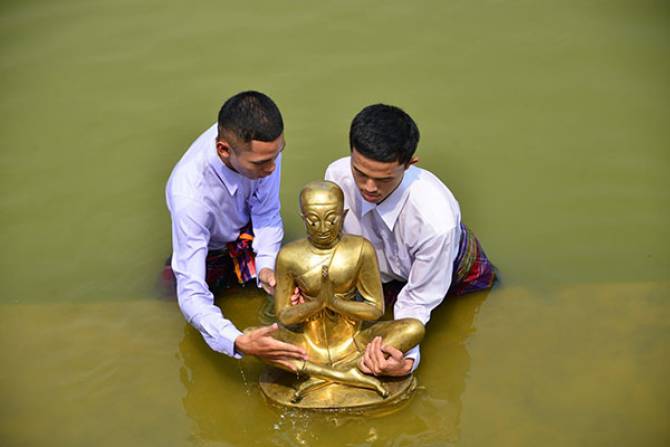 (Photo credit: https://www.banmuang.co.th/news/education/182834)
(Photo credit: https://www.banmuang.co.th/news/education/182834)
Day 2: Prince Vessantara entering the city (Phi Ta Khon parade)
On this day, Prince Vessantara and Phra Upakhut will arrive at the city and the temple, respectively. The villagers and Phi Ta Khon will parade around the city and light fireballs and rockets, dance to traditional folk music until they reach the Wat Phon Chai temple.
 (Photo credit: https://travel.trueid.net/detail/V27xVYEpAxW3)
(Photo credit: https://travel.trueid.net/detail/V27xVYEpAxW3)
Day 3: Ancestors’ day
People will attend religious ceremonies and dedicate merits and good deeds to their deceased ancestors. In general, Buddhists will offer food to monks, listen to the Thet Mahachat sermons (the stories of the great incarnation of the Buddha), and worship sacred objects in temples.
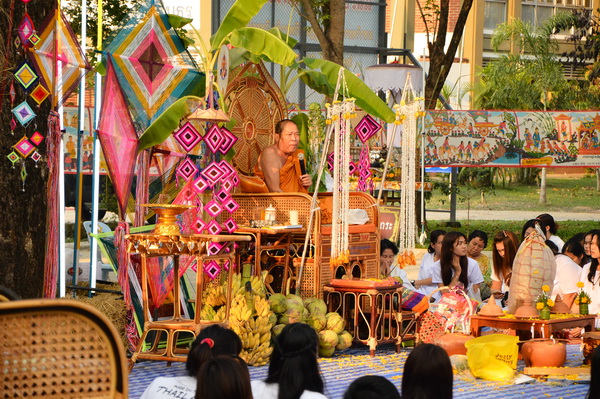 (Photo credit: http://www.mbuisc.ac.th/web/index.php/en/mbuisc-news/1891-2015-02-28-03-41-59)
(Photo credit: http://www.mbuisc.ac.th/web/index.php/en/mbuisc-news/1891-2015-02-28-03-41-59)
Masks and Costumes
Phi Ta Khon’s costume consists of a mask and a dress. The mask is made of a bamboo steamer, folded into a hat-like shape and punched holes for the eyes, with a long and pointed nose made of a piece of wood resembling an elephant’s trunk, and a horn made from dried coconut husks. The mask is then creatively painted to look scary yet fun and exquisite. The dress is made of fabric remnants sewn together, decorated with bells, cow bells, or cans tied at the waist or around the neck so that they make noise when walking and dancing. Every Phi Ta Khon has to carry a sword or a weapon made of wood. There are two types of Phi Ta Khon, which are Phi Ta Khon Yai and Phi Ta Khon Lek.
Phi Ta Khon Yai (large Phi Ta Khon) is made of a large bamboo frame, double the size of a person, and covered with cloth or paper. Each year, there will be only two Phi Ta Khon Yais, a male and a female, decorated in a way that clearly indicates their genders. Ancient beliefs see the human genitalia as a symbol of fertility, not obscenity. People who play Phi Ta Khon Yais must receive permission from a ghost or angel to do so and perform the duty every year for at least three years. At the end of the day, the costumes of Phi Ta Khon Yai must be thrown into the Man River as if to float away misery and bad luck.
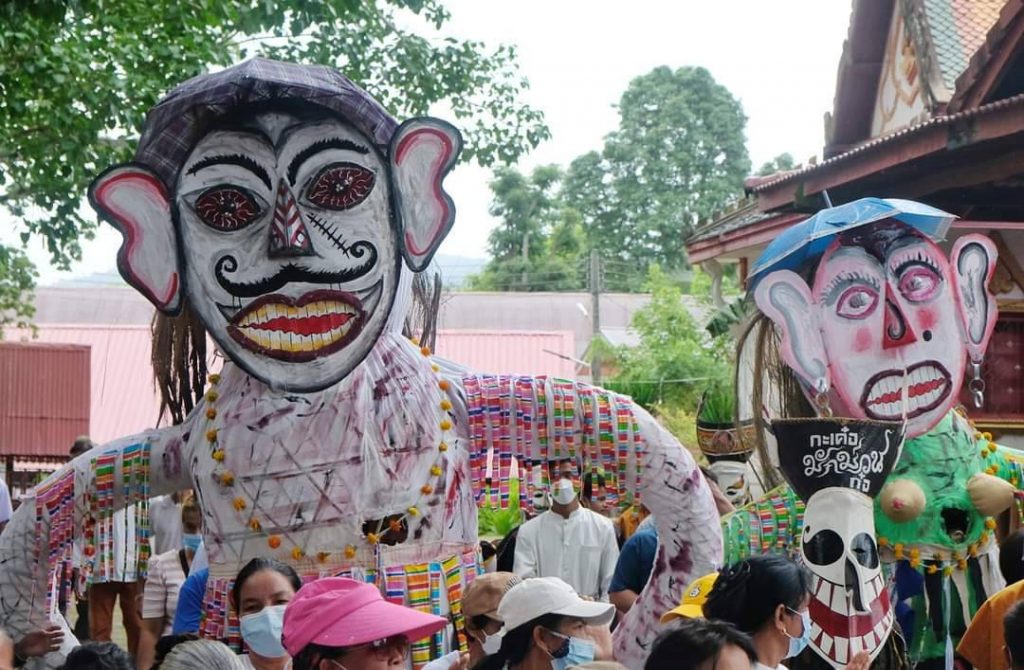 (Photo credit: https://www.komkhaotuathai.com/contents/27177)
(Photo credit: https://www.komkhaotuathai.com/contents/27177)
Phi Ta Khon Lek (small Phi Ta Khon) is a term for people, anyone from young children, teenagers, to adults, who dress up as ghosts, wear the masks as described above, and join the parade. In addition, some people may wear animal body puppets like horses, elephants, or buffaloes and join the parade as animals.
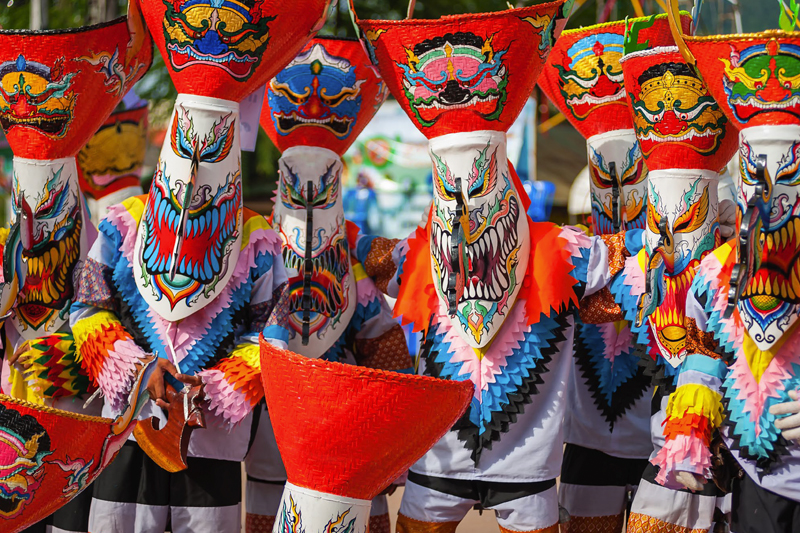 (Photo credit: http://wesmilemagazine.com/phi-ta-khon/)
(Photo credit: http://wesmilemagazine.com/phi-ta-khon/)
Beliefs and rituals
There are four beliefs revolving around the play of Phi Ta Khon. The first one says that this tradition is to worship the sacred spirit that watches over the city of Dan Sai. The second belief, tied to Buddhism, is to welcome Prince Vessantara to the city. Thirdly, the parade is part of the Boon Bang Fai (the traditional rocket festival) and the rain-asking parade. And lastly, the ghosts are a symbol of bad deeds committed in the past year which will finally be floated down the Man River. However, some say that this could simply be just for fun.
Another element worth mentioning is the weapon of the male Phi Ta Khon. It is generally a wooden sword carved into the shape of a penis, called Palad Khik, and painted in a bright shade of red. This is not a weapon for fighting, but for teasing girls who will run away, giggling or screaming. In the eyes of the locals, this is not rude or perverted. On the contrary, it is entertaining to both humans and the archangel Phaya Than who will grant plenty of rain and crops.
Changes
- From fearsome to wholesome
Phi Ta Khon had always been made to look scary and depressing. The Phi Ta Khon costume design had to be kept secret until the day of the parade. However, the style and perception of the Phi Ta Khon mask have now come very far from that. Modern materials such as paper, resin, and oil paint are used to make the masks. The patterns are more diverse, and there is no need to hide it from anyone.
Not only has the costume become more open to creativity and imagination, but this ritual also allows more participants. Dozens of years ago, only adults could play Phi Ta Khon, but today everyone is free to join.
- The costume is preserved.
Instead of discarding all costumes and masks once the parade has ended, people today keep the dresses, the masks and other equipment safe at home, waiting to be reused next year. The idea that Phi Ta Khon’s costume as a reservoir of bad luck seems to disappear.
- Phi Ta Khon as a source of income
The ghost parade has been transformed into a platform of collaboration between the government, the community, and the private sector where many impactful initiatives were born, such as the international masks event, the Phi Ta Khon masks contest, various local performances, trade fairs, and food fairs. It is truly the mega event of the year that attracts both local and international tourists.
In addition, the Phi Ta Khon performance at the Boon Luang festival has been inscribed on Thailand’s National Cultural Heritage List in 2013.
Values
The Phi Ta Khon tradition, like many other Thai rituals, is yet another living proof of how the Thai way of life is intertwined with and inseparable from nature. The awareness of environmental conservation as a treasure passed down from ancestors is expressed through their respect for the city angels and the spirits of their ancestors, the beliefs that tie the Thais to their roots amidst changes. Later, when Thailand was open to Buddhism and the merit-making ceremony, the pre-existing Phi Ta Khon was seamlessly integrated into the religious practice.
At present, the tradition of Phi Ta Khon means much more than a cultural treasure of people in Dan Sai, but gains a new importance as a tourism engine, bringing in income and increasing international recognition to Loei every year.
Above all, Phi Ta Khon is a joyful play born out of the beliefs shared by the local people and maintained from the days of their ancestors to the present. These ghosts are a spiritual anchor that bonds the community with unity and harmony, inspires peace of mind, morale, and hope. Who would believe that such benevolent ghosts exist!
 (Photo credit: https://www.thaiza.com/travel/guide/530120/)
(Photo credit: https://www.thaiza.com/travel/guide/530120/)
Sources
http://ich.culture.go.th/index.php/th/acticleich/1025–m-s
https://travel.trueid.net/detail/V27xVYEpAxW3
http://www.damrong-journal.su.ac.th/upload/pdf/71_8.pdf
https://www.isangate.com/new/31-art-culture/tradition/481-pee-ta-kon.html
_________________________________________________________________________
Author: Soonyata Mianlamai
30 June 2022



